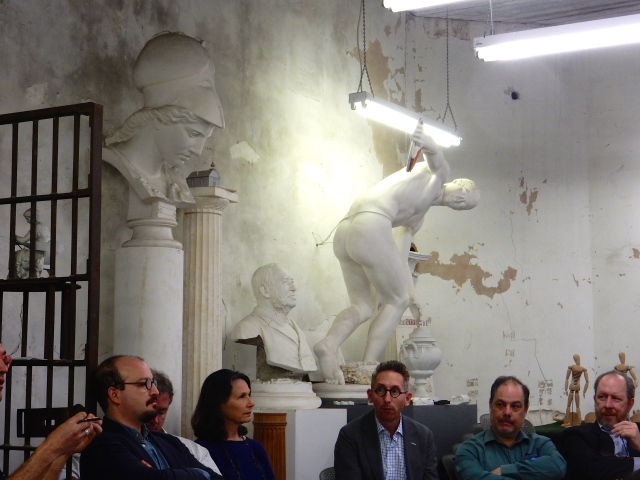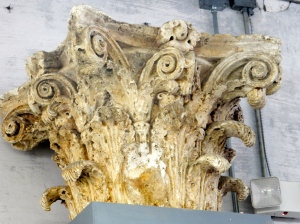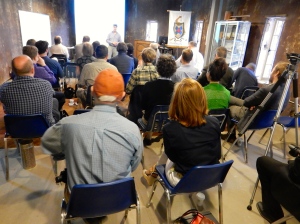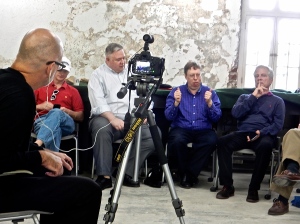
Members of the TradArch listserv, meeting in Charleston, discuss architecture’s future. (Photos by David Brussat)
The gloves came off at TradArch on Sunday, not in the least a day of rest but one on which a host of disputes were engaged. Nothing was resolved, or was likely to be resolved. Each time a voice rang out, trenches on the battlefront advanced or retreated by inches. If anything the trenches were dug deeper. Still, there were soccer games in no-man’s land. Angels danced on the heads of pins. Faces were attached to posts. The TradArch list’s members finally greeted each other and shook hands at a central location. A good time was had by all. Another “garden party” is already in the thinking stage.

Left to right: Anthony James, Padiac “Paddy” Steinschneider, Jenny Bevan, Christopher Liberatos, Patrick Webb.

Andres Duany, with Nathaniel Walker and Katherine Pasternak, finds flaw in archway leading into College of Charleston.
An event planned by “open source” – that is, everyone getting in a room and hashing out topics and schedule by show of hands – is doomed to be messy, and it was. But throw in the parties the evening prior and the tours the day after, and perhaps @TradArch transcended the schismatic fever that prevailed through much of Sunday.
The American College of Building Arts and the College of Charleston, which sponsored the event, deserve everyone’s thanks. The Old City Jail, where the ACBA is headquartered, was a suitably evocative location.
Two principal arguments fed the schism whose persistence among threads on the TradArch list generated this meeting. One is the dispute between orthodox and heterodox classicism. The other is the dispute over whether classicists should use natural materials and traditional fabricating techniques exclusively or man-made materials and advanced fabricating techniques when required by client budgets. I would add a third, the dispute between education or activism as strategies to emphasize in pushing back against the dominance of modernist practice. Of course, education is vital to every facet of the effort to continue the revival of classical and traditional architecture – and there are other disputes in this schism.
I was asked by Patrick Webb, of the ACBA, to open the first session – videotaped by Steve Mouzon. “The built environment deserves to have as many defenders as the natural environment,” I declared. I began to map out a strategy for turning architecture into an effective nonpartisan political issue across the nation. As often happens in largely untethered discourse, I lost control and my monologue was transformed into a dialogue on the closely related question of how to best “frame” the promotion of classicism. Contenders went back and forth on how the public relates to traditional versus modern design.
For example, Dwell magazine was cited again and again. It promotes a modernist lifestyle played out in glass houses. But nobody mentioned the popular reaction against the lifestyle promoted by Dwell, epitomized by the blog Happy Hipsters, which features photographs from Dwell with captions reflecting the real feelings of the victims of such architecture. In one case, a man sits on a stool at the bar in his open-plan living room. The caption reads, “He knew to wait until the skies were clear before he re-entered the kitchen.”
Put that in your glass box and smoke it! People who live in … ah, forget it!
I missed one round of paired sessions, but my impression was that the discussion was dominated by a succession of classicists attempting to deflect the conversation in the direction of their own preferences and interests. That doesn’t mean it wasn’t useful.
An action photo I took amid the heat of one discussion shows Andrés Duany, leader of the New Urbanist movement and, recently, consultant to Charleston, shushing someone interrupting a point being made by architectural theorist Bruce Donnelly.
Duany and Chrisopher Liberatos, who with his wife Jenny Bevan own a design firm in Charleston and uphold what Duany calls the “Palladian” discourse, from which the “garden party” imagery arose, were the most vocal advocates of their respective sides of the schism. (See video at end of post.)
By the end of the day, no faction seemed to be entirely reconciled with its rival, but each side better understood the other. There were some sharp exchanges but no fisticuffs. A roundup session later in the evening was subsumed in the bonhomie of beer.
Michael Mehaffy, an urbanist from Portland, Ore. (formerly with the Prince’s Foundation on the Built Environment, in Britain), who comes as near as anyone to bridging the schism, has submitted to TradArch for comment a list of principles emerging from the weekend. Liberatos and Bevan, with others, are working on a Charleston Charter to try to kick the modernists out of the bed of the preservationists (or, actually, vice versa). Duany has, it seems, reached the final stages of his treatise, the Heterodoxia, which traces the classical discourse through 600 years of doctrine and practice, framing an effort to put it back on track – a “call to order” – after decades, even centuries, of “drift.” (Fatuous journalist disclosure: I am editing the latest version of the treatise.)
I declare on a stack of bibles that my editing has nothing to do with the fact that Liberatos & Co. will be astonished at the Heterodoxia’s reverence for and deep understanding of the orthodox classical canon. Everyone seems to think Duany seeks to undermine it. Even his editor fears the winner of the 2009 Driehaus Award might go too far, not just recapturing some late-19th century classicists from the modernists but rebranding as “classical” some 20th-century modernists who should be left to stew in their own ridiculous juices. Be that as it may (and it may not be cast in stone), Duany’s recognition of classicism’s superiority, by far, to modernism rings clear throughout the document.
The first of the two presentations Duany managed to squeeze into Sunday’s tight schedule was about Léon Krier’s recent lecture in which he redesigns some of modernist founder Le Corbusier’s old buildings. What Duany should have said is that Krier, who is famous for his tart architectural cartoons, didn’t go far enough. Even classicists who have risen above their modernist “education” often retain a devotion to the fraudulent sophistication of the heroic early modernists, especially Corbu. In fact, the best way to redesign Corbu is with a stick of dynamite.
Duany’s second lecture explained his treatise, part of which is a history of treatises in the discourse of classical architecture. Listening to his lecture was Katherine Pasternak, who is among the four authors of the Heterodoxia. Her collection of original editions of the major classical treatises, about 150 documents, and her conversations with Duany about them, has been of immense influence on the Heterodoxia’s analysis of how the famous early treatises (Vitruvius, Palladio, Serlio, etc.) and their “human, all too human” characteristics caused classical architecture’s original schism.
The take-away from @TradArch? It may be that if the original schism planted the seeds of today’s classical disputations, modern schismatics should yet be mindful that they have in common everything of importance – above all, a common enemy that can win in the long run only if classical architects embrace the strategy of the circular firing squad.
[I returned late Tuesday night from a delightful four days in Charleston, housed by my good friend and recent Brown graduate Nathaniel Walker – who now teaches architectural history at the College of Charleston and helped arrange the conference. Next in line are photographic essays (mainly) on Charleston and the nearby town of I’On, planned by Duany’s firm DPZ. I may also post on more issues arising from a most fascinating weekend.]









Pingback: Andres Duany at TAG 4.2 | Architecture Here and There
Mr. Brussat, I appreciate AH&T. Thank you for it.
– I’m curious, in what context does TradArch (or any such event) matter? Will such events help expand the scope of allowable grandfathering of architectural elements not meeting “Modern” building codes? Do such events progress toward closing the loopholes, in the SOI’s Standards for Rehabilitation, that questionably allow Modernization of historic structures? Will they lead to public outreach and education about the appropriate design and use of common construction materials (ie. brick veneers, exterior shutters, traditional window design, and etc.)? Are there any efforts to work with the spec home industry to economically ‘raise the bar’ on what is arguably a travesty of indifference toward harmonious architectural design? Or is TradArch a more insular, philosophical event, the outcome of which isn’t intended to benefit anyone but those who participate? Thank you for your consideration.
LikeLike
Acroteria – Thank you for your interesting question. All of those things that you want to happen as a result of the conference of TradArch are important things. And yet none of them will happen as a result of the conference, perhaps because it was a “more insular, philsophical event.” And maybe it will benefit only those who participated. But there is a possibility that some inner flame of motivation was sparked that will push the classical revival further toward a tipping point, at which junction, sooner or later, all those subjects which interest you and many others, including those on TradArch, will be more likely to be addressed. If that happens, everyone will benefit, except the modernists (and even them to the extent that they are human). The conference probably made that a little more likely. That sounds like a worthy accomplishment to me.
LikeLike
“All of those things that you want to happen as a result of the conference of TradArch…”
I didn’t say I want anything to happen as a result of the conference of TradArch. How could I have expectations of an event of which I have no knowledge? Anyway, thank you for your reply. I have a follow up question: “…will push the classical revival further toward a tipping point…” toward what? I ask because you also wrote, “If that happens…”, but you never state what the “that” is, toward which the classical revival is tipping.
LikeLike
Acroteria – In reply to your reply to my response to your comment, that is a good question. I try to make sure my posts are accessible to those outside the TradArch circle, but I do not always succeed. The “tipping point” toward which I hope the classical revival is moving would involve voters pushing politicians to encourage developers to propose projects voters are more likely to appreciate, and ending up with a level playing field for major civic and institutional commissions in those largely governmental agencies and commissions through which proposals must pass to get permits. I personally believe that if the playing field were ever actually level, proposals with modernist designs will actually disappear from the scene rather swiftly and the classical revival will be complete (although naturally architects will continue to debate stylistic points). Is this a bit clearer? Thanks much for your interest.
LikeLike
Wow. I think Patrick Webb nails it above. Bear in mind that modernism parallels the rise of the middle class, during which time a wholesale architectural/cultural identity accessible to all, and requiring no formal educational prescription emerged. With mass markets and efficiency in mind (and I keep saying this, David), Modernism became an outgrowth of the petroleum age. Baring a rapid green/sustainable revolution, and assuming oil remains the principle source if our fabricated wealth, expectations for an ebb of Modernist ideology any time soon is unrealistic. Alas, for our time, the best Modernists are Classicists (and vice-versa).
LikeLike
Modernism did not take over the industry in any natural way. It bullied its way in, relied on false accusations of tradition = fascism, used totalitarian and even thuggish tactics to drive traditionalists from the profession and now uses Orwellian institutional strategies to maintain control in the face of vast popular dismay with the built environment, and with modernism in particular. It is wrong to suggest that tradition could not have survived in a petro world, wrong to think only modernism is viable in that world, wrong to turn the other cheek just because a counterrevolution might take a while. That may not be everybody’s fight, and I have no quarrel with those who must go along with modernism to make a living in the profession, but everybody will win if the modernists, upon some future tipping point, go away.
LikeLike
“…false accusations of tradition = fascism…”. Actually, it was the other way around. And don’t forget that, at the time, Fascism didn’t have the negative connotations it does today; so the accusation wasn’t an automatic insult. But the Modernists did say traditional ways of doing things led to the world’s problems and a new “international” way of thinking was a solution. Later, Hitler would expel Modernist architects and artists (not just because many of them were Jews) and use classical architectural forms to advocate the power of the State; an idea the Modernists quickly adopted. If anything, I hope one understands the background of the Modernist vs. Traditionalist schism isn’t quite so black and white.
LikeLike
David, while I am sure the gathering in Charleston was beneficial to most everyone who attended, the real problem is that classicists continue to define themselves in opposition to modernism and as long as that is the case, very little will be achieved. Modernism happened and classicism lost much of the influence it once had. That is a simple fact of history and a much more complicated story than what is typically postulated by the classicists (the evil pioneers …). As it stands, modern classicism represents a tiny (and here I would say mostly irrelevant) place in contemporary debates about building. This is sadly the fault of modern classicists who want to have there cake and eat it too – the ones who want to a place at the table only to condemn the industry. There are a lot of people interested in classicism (historians, designers, archaeologists, and architects) who are not remotely associated with the very small world of modern classicism that met in Charleston recently.
LikeLike
We’ll have to agree to disagree on much of what you say, Victor. As a simple fact of history, the dominance of architecture by modernism can by reversed by history’s cycles, but not if nobody tries. And while most people try to ignore their built environment (thank you, modern architecture!), many prefer the alternative, which is making progress in a small way. Intelligent activism can push toward a tipping point that could change that, but not if we all just say, “Well, modernism’s in the catbird seat and nothing can change that.” This is false, and I think notwithstanding the disagreements in Charleston, most advocates of traditional architecture believe that in a democracy, the public will can, under the right circumstances, have its way. Criticizing modernism is a key part of the mix that could achieve those circumstances. I trust that most of the modern classicists in the industry, who do the work of designing and building day after day, who are not on the TradArch list (let alone attended the conference) would be disappointed to hear that someone like you has lost all hope.
LikeLike
David, thanks for your thoughtful reply. I haven’t lost hope at all. I just no longer go around proclaiming the evils of Modernism (given that not all of it is bad and we live in a modern world). Like the President of the US, I am in favor of helping Cuba change by moving forward – not by declaring it the evil empire. Modernism has changed significantly and even has embraced classicism, even if the strong majority of classicists act like Tea Party activists who throw rocks at glass houses. I sincerely believe that the only classicists who will be upset with me are the ones who thought that I was somehow a champion of that strategy. The task is not to criticize Modernism, but to criticize bad architecture (modernist, classicist, etc). I hope this clarifies any misunderstandings I may have conveyed in my previous post. My best, Victor
LikeLike
Victor, regarding your reply to my reply, I think all strategies for reversing modernism are appropriate, even if none are likely to succeed. There is a chance that they could succeed, and I think that chance is worth taking. After all, modernism itself captured the entire field of architecture within a moment of time. And bashing modernism is perfectly appropriate, no less so than bashing bad traditional design, which I often do. There is modernism that is good within its own flawed weltenschung (sp?), but if a more natural, humanistic world view is preferred, modern architecture is not sustainable and it stands in the way. Calling spades spades is something I will continue to do. I hope you will enjoy it even if you don’t think it helps much!
David
LikeLike
Victor, I’ve only recently started looking at what others are saying and it seems the “stars of traditional architecture” are doing very little other than criticizing Modernism. David’s reply to my question leads me to further believe Traditionalists seem to want it all before they try to get a little more than they have now. Apparently, they’ll just wait, to do anything, until after someone hands traditionalism the top spot.
LikeLike
I don’t think that’s a valid characterization of what traditionalists are doing. They are not just waiting around till “after someone hands us the top spot.” Most are working to try to get commissions then design and help build them when they do. That’s a lot of work and it doesn’t leave much time for activism. Many are discussing options on TradArch. There may be other listservs where that or more is going on. There is an Institute of Classical Architecture & Art that does a lot of educational work, and some of us have argued that it should do more advocacy, by way of raising questions about modernism and specific modernist projects. But for those who are traditional architects or who prefer such work, there is very little by way of institutions to lead efforts to bring about an even playing field in architecture. The faculty at the several classical architectural programs in the schools do a lot of good research and writing. Of the 150 or so academic programs in architecture, however, just two, three, maybe four are traditional. The rest are modernist, and almost all of those refuse to permit any sort of traditional curricula – often even purging architectural history. Conferences such as the TradArch conference in Charleston are trying to push the situation forward, but there is no power center such as the AIA for traditionalists, and AIA seems to think that traditional work is not a part of the field of architecture. So we do what we can do.
LikeLike
There was one thing that occurred that, as host, I felt really terrible about. I had arranged for craftsman and I’On resident Bill Hussey to lead the tour there. Andres asked if he could join in, which with Bill’s consent I arranged. When Andres and Vince arrived they took over 100%. I’m quite certain it was a bully play to squelch any possible criticism of their work. Not only was it common and rude, it was also impractical. How can we improve if we are willing to toss ethics and civil behavior aside for such a defensive posture?
LikeLike
I do not know Vince but I suppose it is inevitable that someone like Andres will take over a room (or tour, whatever) by sheer dint of personality. I’m sure he is sensitive to the critique of I’On from Chris and others on materials and techniques. I’m the strongest advocate of natural traditions of craft, but also recognize that for the classical revival to advance it must embrace advanced materials and techniques to keep costs down. If classicism is only the province of the rich, it will be only that much harder to bolster the preference already existing for it among most people. They often buy into the past/future meme because there are so few new classical civic and institutional buildings, and consider classicism a beauty whose time has regrettably passed. If an even playing field for major commissions can ever be secured, modernism will wither, classicism will rise again, and the use of craft will become more widespread, enabling increased affordability. It seems evident to me that in the meantime – which could be lengthy – both approaches must be considered equally valid. (By the way, what is the name behind “realfinishes”?
LikeLike
Monumental Classical architecture is most often a display of wealth, individual or civic. So is monumental Gothic, Islamic, Modernism etc. However, vernacular hand craft at the domestic scale has existed for millennia. I would wager that a hand crafted vernacular home is cheaper per ft2 than an ultra modernist one of the same size and will avoid obsolescence to boot. Neither one can compete with an industrial produced tract home that is not designed to last the mortgage. It’s a question of values: The building as a short term investment with a 5 year ROI, wholly dependent on mechanical systems versus a long term investment that can be handed over generationally.
A side point is that the study of Classical architecture it is primarily a system of education that prepares one to work at a variety of scales and styles many of which are not Classical at all. I’m not a Classicist, I seldom do “Classical” work; however, I appreciate the rigour and discipline of the system that informs my practise.
As a plasterer I had learned a number of traditional methods working on heritage properties in Paris and Venice. They are the “real” finishes that all of the ragging and sponging of acrylics, “faux” or false finishes try to emulate. Now it serves as my blog of advocacy for craft in general: http://www.realfinishes.com
PS: I have received a number of offers from the adult entertainment industry interested in purchasing the domain…
LikeLike
Patrick, I wish you had stuck around at I’On, because you would have heard a lot of criticism of the place by both Andrés and Vince. Was Bill there? I don’t believe I know him. If he was, he should have joined in. Most New Urbanists operate on the basis of “if you have something worthwhile to say, say it.” Both Erik Bootsma and David Rau participated quite a bit, and they had no special insights like Bill would have.
LikeLike
I don’t know David, I felt like the gathering brought me a lot closer to a number of the folks who attended. Might even be participating in next year’s CNU by the sounds of it! Katherine, Helen, Beth, Paddy, Bruce and Roy, all these folks I met for the first time were really delightful. I come from more of an Arts & Crafts background personally; however, I appreciated the work put together on the Heterodoxia plates. I thought most everybody did in fact. Looking forward to seeing them published. Andres, Steve and I were airing our differences on the listserv; nevertheless, I think we also had some quality time quickly burying that and moving on with the work to be done. Maybe that was my singular experience.
LikeLike
I think you are on target, and pretty much as I think I put it – a little of this, a little of that, some harsh words but mostly agreement to disagree over bridgeable gaps unlikely to be fully bridged. Not in the least a useless seminar. Very healthy and generally good spirited.
LikeLike